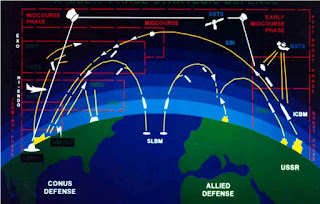Death by Defense Spending - The Collapse of the Soviet Union and the Strategic Defense Initiative
Source: GlobalSecurity.org
Mutually assured destruction (MAD) has been a fundamental concept since the 1950s, when both the United States and the Soviet Union acquired massive amounts of nuclear weapons, making it impossible for either nation to "win" a nuclear war. But, during the 1980s, a certain actor turned governor turned President of the United States - Ronald Reagan - had a different view on MAD, viewing it as a suicide pact. With tensions between the US and USSR soaring following the Soviet invasion of Afghanistan and the 1980 Olympic boycott, Reagan publicly announced the Strategic Defense Initiative (SDI) on March 23, 1983.
The SDI, at its most basic level, was an anti-ballistic missile system. The proposals for actually shooting down the ICBMs - which were moving at several thousand miles per hour at high altitudes - were extremely interesting. Among other proposals, the government looked at using nuclear explosions to power X-ray lasers, which would be used to disable incoming missiles in space. This proposal, known as Project Excalibur. Excalibur was unique in that a single unit could destroy dozens of ICBMs, in contrast to most anti-ballistic missile (ABM) systems where dozens of ABMs are required to shoot down just a single ICBM. However, Excalibur's technology was simply too advanced, and by 1986, it largely had died. There were also ideas to use space-based rail guns, chemical powered lasers, and tungsten projectiles in order to destroy Soviet ICBMs. However, these efforts faced numerous technical problems, and launching large amounts of weaponry into space is no cheap endeavor. A combination of these factors is why SDI does not exist today - but in the 1980s, it was considered to be a real possibility - and threat.
The SDI was meant to essentially make MAD obsolete. By shooting down incoming Soviet nuclear warheads, the United States would be able to defend itself in the event of a nuclear first strike by the Soviet Union. In the eyes of the Soviets, however, the SDI was insanely aggressive, as it essentially allowed for America to launch a nuclear attack against the Soviet Union for fear of retaliation. The Soviets proceeded to spend billions of dollars developing their own systems to counter the SDI. The Buran shuttle, for example, was a Soviet version of the American space shuttle designed to put military spacecraft into orbit. It is estimated that billions of rubles were spent to develop the craft, which only flew once in 1988 and failed in its task of putting an orbital laser into orbit. However, the Soviets also knew that they could not sustain an all-out arms race. Their economy was stagnant and faltering, in large part due to the inefficiencies of a command economic system. There was simply no way for the Soviets to build an arsenal capable of overwhelming the SDI without going bankrupt. Facing the choice of either reform or the possibility of being wiped out by the United States, the Soviet Union was in an incredibly difficult position by 1985, when Gorbachev came to power.
Gorbachev had realized that the communist system was bound to fail early on, and the inability of the Soviet Union to match the SDI only served to further convince him of this truth. His leadership would therefore be reformist, a last-ditch attempt to save the Soviet Union. His attempts at economic reform, however, simply opened the floodgates for Soviet collapse. Once given a taste of capitalism, the people of the Soviet Union desired more capitalism, and a total end to communism. Mere reform wouldn't do - only the end of communism all together would satisfy the hundreds of millions of Soviet citizens. The Baltic states broke away, the Berlin wall fell, and a communist hardliner coup in August of 1991 was defeated, in large part thanks to Boris Yeltsin. By December of 1991, America's enemy for the past 45 years had collapsed, and the once mighty Soviet Union was now 15 different countries.
SDI, scientifically and technologically, was a failure. It was too advanced for its time and too costly to implement it. Politically, however, it was a success. By forcing the Soviet Union into economic reform, it paved the way for the collapse of the Soviet Union, ending the cold war. SDI serves to teach modern leaders a vital lesson about military power, in that it is not only useful for war and military conflict, but also political conflict. The mere threat of an opponent with vastly superior firepower is enough to send even the most powerful regimes into disarray - even today, we see this with North Korea's potential capability to launch a nuclear strike against the US. When America spends 700 billion dollars annually on the military, it is not merely to wage war against illiterate goat-herders in the Middle East. It also serves to intimidate America's potential adversaries from Moscow to Tehran to Beijing, which drives concessions at the negotiating table and serves as a valuable deterrent against aggression towards American allies.



Comments
Post a Comment